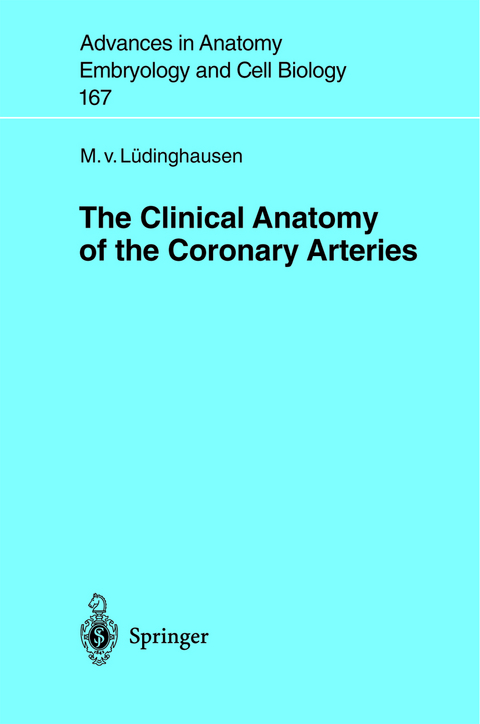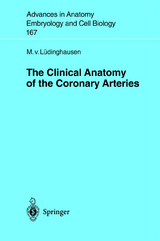The Clinical Anatomy of Coronary Arteries
Springer Berlin (Verlag)
978-3-540-43689-8 (ISBN)
Considerable advances have been made in cardiology during the last few decades. In particular, there has been great progress in the field of coronary angiography both when combined with, and without, computed tomography (CT) and magnetic reso nance (MR) imaging. These techniques of modern imaging allow the cardiologist and coronary surgeon to study every cardiac structure in detail, both two- and three-di mensionally and from either side, to analyze the movements of the heart and valves, and to observe myocardial circulation and even myocardial metabolic processes. However, coronary heart disease, a multifactorial illness of the coronary vessels, still remains the most common cause of death in developed countries. In addition to the large group of patients suffering from coronary heart disease, there is a smaller group of children and adults who are in need of open heart surgery and,most frequently,valve surgery.Avery small number of individuals suffering from Wolff-Parkinson-White syndrome still await competent surgical intervention. These three groups of patients have in common that, for them, meticulous preop erative diagnostics and preparation for surgery are urgently required. Any open heart surgeon who carri es out procedures in the coronary or interventricular grooves or on the atrial walls of the heart must take the normal and anomalous origins,courses, and terminations of cardiac vessels into consideration. Therefore, with the availability of precise anatomical and physiological data,operation time will be shortened, operative risks will diminish, and the safety of the operation for the patient will be greater.
1 Introduction.- 1.1 Aims of the Study.- 1.2 The Cardiac Vascular Systems: The Coronary Arteries and Cardiac Veins.- 2 The Significance of the Proper Vessels of the Human Heart in Statistics and Diagnostics.- 2.1 Angiography.- 2.2 MR Imaging.- 2.3 Ultrafast MR Imaging.- 2.4 Coronary MR Angiography.- 2.5 Conventional and Ultrafast Computed Tomography (Cardio-CT).- 3 Nomenclature.- 3.1 English and Latin Versions.- 3.2 Abbreviations.- 3.3 Commonly Used Unofficial or Alternative Terms and Synonyms.- 4 Results and Discussions.- 4.1.1 The Anatomy of Coronary Arteries in General.- 4.2 Peculiarities of the Origin of the Coronary Arteries.- 4.3 Coronary Dominance or Preponderance.- 4.4 Intramural (Intramyocardial) and Intraluminal Courses of the Coronary Arteries.- 4.5 Atrial Branches and the Arterial Supply of the Conduction System.- 4.6 Arterial Supply of the Interventricular Septum.- 4.7 Blood Supply to the Coronary Arteries (Vasa Vasorum).- 4.8 Coronary Anastomoses and Collaterals.- 4.9 The Coincidence of Coronary Artery Anomalies and Atherosclerosis.- 4.10 Age-Related and Atheromatous Coronary Calcifications.- 4.11 Anatomical Aspects of Surgical Interventions in Coronary Atherosclerosis.- 5 Concluding Remarks.- 5.1 Individual Coronary Anatomy.- 6 Summary.- 99.- 113.
| Erscheint lt. Verlag | 27.11.2002 |
|---|---|
| Reihe/Serie | Advances in Anatomy, Embryology and Cell Biology |
| Zusatzinfo | VIII, 116 p. |
| Verlagsort | Berlin |
| Sprache | englisch |
| Maße | 155 x 235 mm |
| Gewicht | 255 g |
| Themenwelt | Medizinische Fachgebiete ► Innere Medizin ► Kardiologie / Angiologie |
| Studium ► 1. Studienabschnitt (Vorklinik) ► Anatomie / Neuroanatomie | |
| Schlagworte | Anatomie • anatomy • Aneurysm • Angiography • Arterien • Arterien / Schlagadern • atherosclerosis • Blood • calcification • Computed tomography • Computed tomography (CT) • coronary • coronary aneurysmata • Coronary arteries • Diagnostics • heart • Herz (anatom.) • Herz (Anatomie) • invasive diagnostics • Morphology • non-invasive |
| ISBN-10 | 3-540-43689-8 / 3540436898 |
| ISBN-13 | 978-3-540-43689-8 / 9783540436898 |
| Zustand | Neuware |
| Haben Sie eine Frage zum Produkt? |
aus dem Bereich




